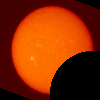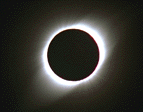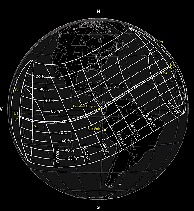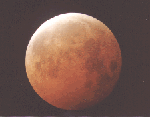Eclipses
Eclipses are caused by particular arrangements in space of the earth, moon, and sun.

The sun is about 400 times larger than the moon, but it also happens to be about 400 times farther away. So the sun and moon appear to be the same size as seen from the earth. Therefore, when the moon passes exactly between the earth and the sun, it completely covers the sun's disk. When this happens, we can see the sun's corona, a layer of hot gases that surround the sun. The corona is normally not seen because the sun's disk is so much brighter

Viewing a solar eclipse can be very dangerous. You should, of course, never look directly at the sun. If you do, the heat, light, and UV radiation can damage your eyes, usually causing full or partial blindness. Normally you can't look directly at the sun - your eyes will automatically close. During an eclipse, when the sun is not so bright, this eyelid response may not happen. However, if any part of the sun's disk is showing, it's bright enough to cause damage. There are special filters made specifically for looking at the sun safely. But it is NOT safe to use film, sunglasses, smoked glass, or other such devices. The safest method is using a projection method.
Every year has at least two solar eclipses, and there can be as many as five, but this is very rare. The next total solar eclipse visible from South Carolina will be in 2017.

Lunar eclipses are more readily seen than solar eclipses. Every one on the correct side of the earth can see a given lunar eclipse. Lunar eclipses are also perfectly safe to view. No special precautions are needed.
There can be up to three lunar eclipses in a year, but some years there are none.
For more detailed information on eclipses, see
